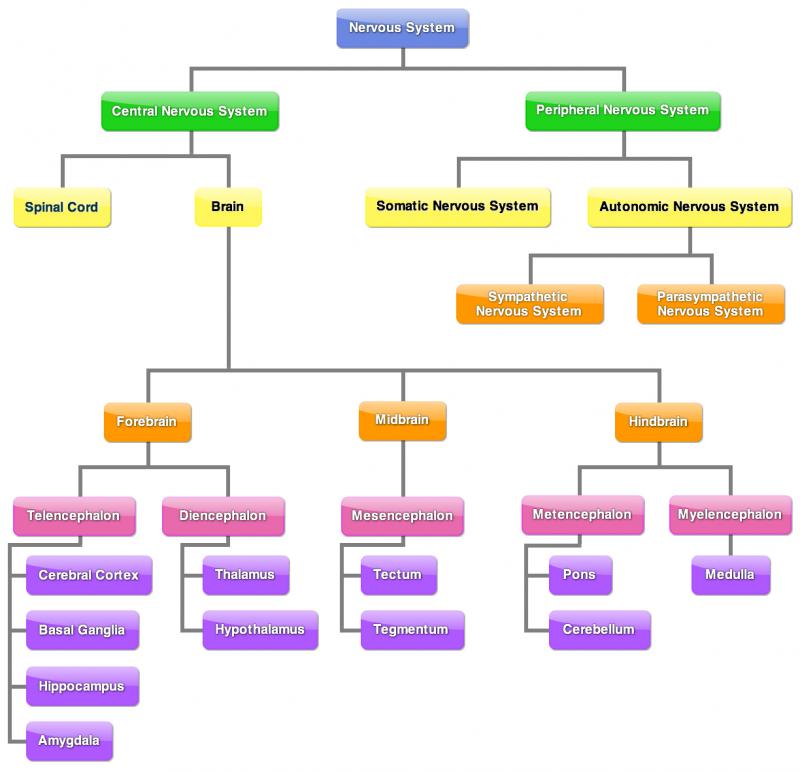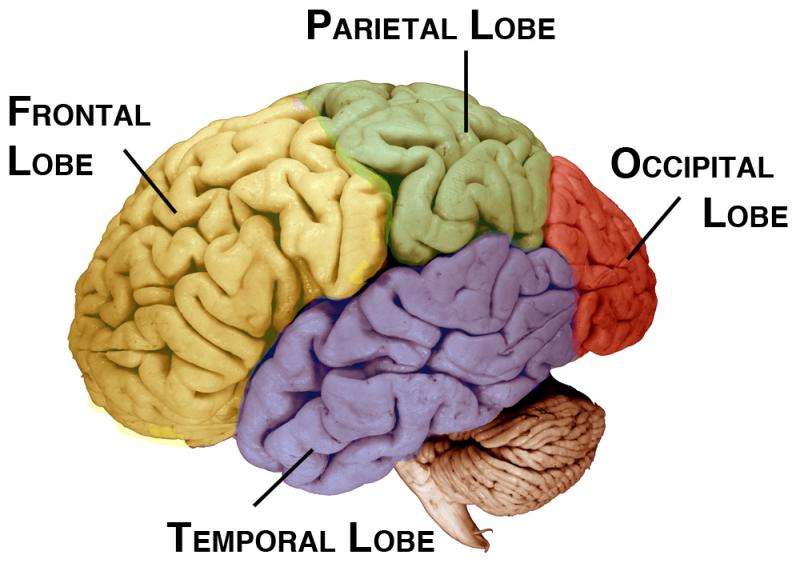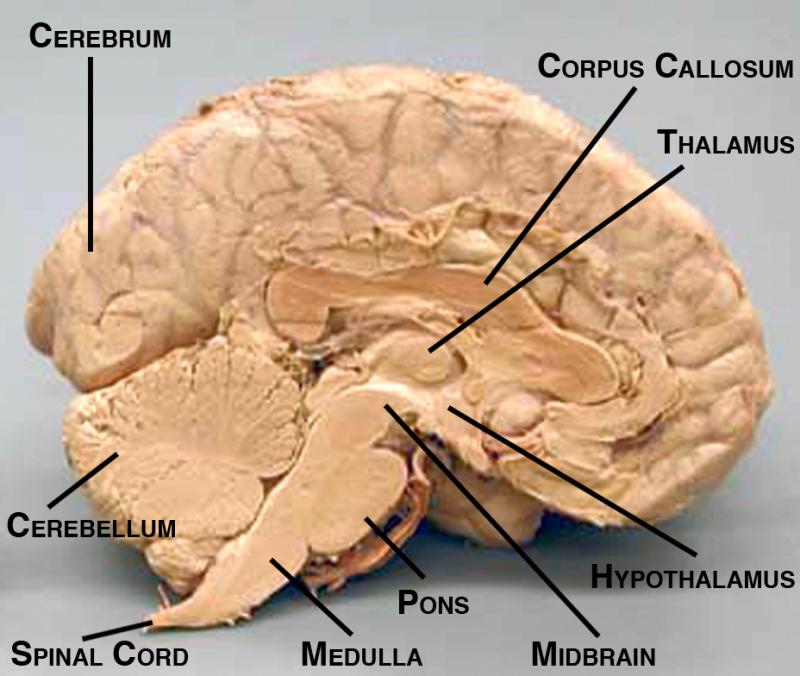Serendip is an independent site partnering with faculty at multiple colleges and universities around the world. Happy exploring!
The Nervous System
 The nervous system is your body's decision and communication center. It is a complex network that receives sensory data from inside and outside the body, responds to changes and demands, initiates and executes movements, and maintains your body's homeostasis. The nervous system can be divided into two main categories: the central nervous system (CNS) and the peripheral nervous system (PNS). The central nervous system consists of the brain and the spinal cord. The peripheral nervous system is made of into the somatic nervous system and the autonomic nervous system, which is further divided into the sympathetic nervous system and the parasympathetic nervous system. Since this exhibit focuses on the brain, suffice it to say that the peripheral nervous system is a network of nerves.
The nervous system is your body's decision and communication center. It is a complex network that receives sensory data from inside and outside the body, responds to changes and demands, initiates and executes movements, and maintains your body's homeostasis. The nervous system can be divided into two main categories: the central nervous system (CNS) and the peripheral nervous system (PNS). The central nervous system consists of the brain and the spinal cord. The peripheral nervous system is made of into the somatic nervous system and the autonomic nervous system, which is further divided into the sympathetic nervous system and the parasympathetic nervous system. Since this exhibit focuses on the brain, suffice it to say that the peripheral nervous system is a network of nerves.
Together, the central nervous system and the peripheral nervous system control every part of your daily life, from breathing and blinking to helping you memorize facts for a test. Nerves reach from your brain to your face, ears, eyes, nose, and spinal cord... and from the spinal cord to the rest of your body. Sensory nerves gather information from the environment, send that info to the spinal cord, which then speed the message to the brain. The brain then makes sense of that message and fires off a response. Motor neurons deliver the instructions from the brain to the rest of your body. The spinal cord, made of a bundle of nerves running up and down the spine, is similar to a superhighway, speeding messages to and from the brain at every second.
The brain is made of three main parts: the forebrain, midbrain, and hindbrain. The forebrain consists of the cerebral cortex, thalamus, and hypothalamus (part of the limbic system). The midbrain consists of the tectum and tegmentum. The hindbrain is made of the cerebellum, pons, and medulla. Often the midbrain, pons, and medulla are referred to collectively as the brainstem.
See the diagram below for a more detailed overview of the organization of the nervous system. Scroll past it for more information on the structures of the brain. If any of the terms are confusing to you, be sure to look at the glossary!

Divisions and Structures:
Telencephalon: cerebral cortex, corpora striata (caudate nucleus, internal capsule, putamen), and rhinencephalon (e.g., olfactory bulb, hippocampus, amygdala, septal region, and cingulate cortex)
Diencephalon: thalamus, hypothalamus, pineal gland, and posterior lobe of the pituitary (a migrated portion of the hypothalamus)
Basic Functions:
- cognition
- movement
- sensory processing
- learning
- memory
- language
- motion
Cerebral Cortex and Cerebrum
The cerebral cortex is a thin layer of tissue comprising the outermost layer of the cerebrum. The cerebral cortex is composed of neural cell bodies, which give the cortex a grey color, hence the name "grey matter". Conversely, "white matter" is composed mainly of myelinated axons, which carry signals from neural cell bodies to other parts of the brain and body.
Together, the cerebral cortex and the cerebrum are the largest part of the human brain, associated with higher brain function, such as consciousness.
Note that the cerebral cortex is highly wrinkled. Essentially this makes the brain more efficient, because it can increase the surface area of the brain and the amount of neurons within it. We will discuss the relevance of the degree of cortical folding (or gyrencephalization) later. (Go here for more information about cortical folding)
A deep furrow divides the cerebrum into two halves, known as the left and right hemispheres. The two hemispheres look mostly symmetrical, yet it has been shown that each side functions slightly differently than the other. Sometimes the right hemisphere is associated with creativity, while the left hemispheres is associated with logic abilities. The corpus callosum is a bundle of axons which connects these two hemispheres.
Neocortex
The neocortex occupies the bulk of the cerebrum and cerebral cortex. It is a six-layered structure found only in mammals. It is thought that the neocortex is a recently evolved structure, and is associated with "higher" information processing in more fully evolved animals (such as humans, primates, dolphins, etc). For more information about the neocortex, click here.
The neocortex is divided into four sections, called "lobes": the frontal lobe, parietal lobe, occipital lobe, and temporal lobe. Below is a visual representation of the neocortex:

What do each of these lobes do?
- Frontal lobe: associated with reasoning, planning, parts of speech, movement, emotions, and problem-solving
- Parietal lobe: associated with movement, orientation, recognition, perception of stimuli
- Occipital lobe: associated with visual processing
- Temporal lobe: associated with perception and recognition of auditory stimuli, memory, and speech
Limbic System
The limbic system, often referred to as the "emotional brain", is found buried within the cerebrum. Evolutionarily, the structure is relatively old. In other words, an animal which scientists assume to have evolved prior to humans may have a limbic system but not a neocortex.
This system contains the thalamus, hypothalamus, amygdala, and hippocampus. Below is a midsagittal view of the human brain, with several structures labelled (some limbic system structures are not visible from a midsagittal cut due to their locations):

Thalamus: sensory processing and motor functions
Hypothalamus: emotion, thirst, hunger, circadian rhythms, body temperature, and control of the autonomic nervous system
Amygdala: memory, emotion, and fear
Hippocampus: learning and memory -- converting short-term memory to long-term memory, and recalling spatial relationships in the world around us
Divisions and Structures:
Mesencephalon: tectum (inferior and superior colliculi) and tegmentum
Basic Functions:
- vision
- hearing
- eye movement
- motor control
Divisions and Structures:
Metencephalon: pons and cerebellum
Myelencephalon: medulla
Basic Functions:
- monitoring and controlling body movements
- homeostasis
Cerebellum
The cerebellum, or "little brain", is similar to the cerebrum in that it has two hemispheres and has a highly folded surface, or cortex. This structure is associated with regulation and coordination of movement, posture, and balance. It is assumed to be much older than the cerebrum, evolutionarily. In other words, animals which scientists assume to have evolved prior to humans, for example reptiles, do have developed cerebellums. However, reptiles do not have neocortex. Go here for more discussion of the neocortex.
Brainstem
Structures:
midbrain (tectum and tegmentum), pons, and medulla
Underneath the limbic system is the brain stem. This structure is responsible for basic vital life functions such as breathing, heartbeat, and blood pressure. Scientists say that this is the "simplest" part of the human brain because the entire brains of evolutionarily older animals (for example, reptiles) resemble the human brainstem. Look at a good example of this here.
Would you rather go back to slicing or move on to magnification?





Comments
Post new comment